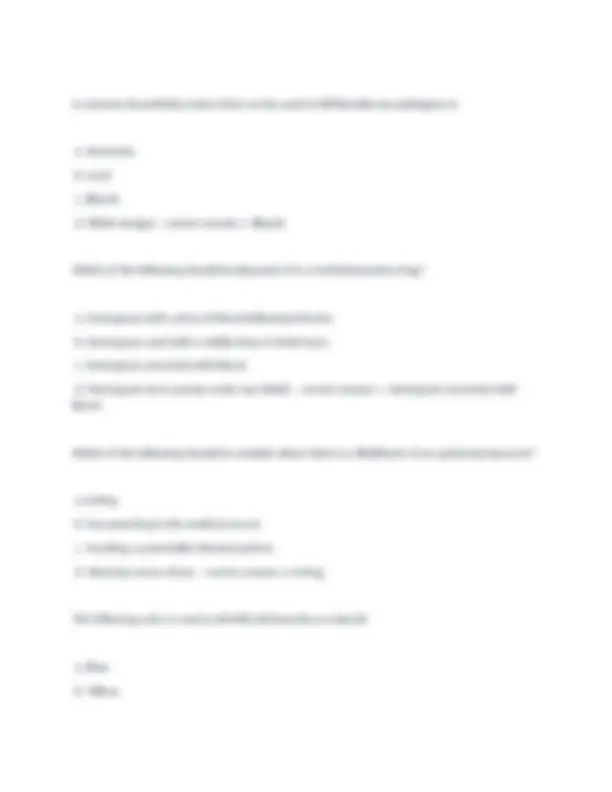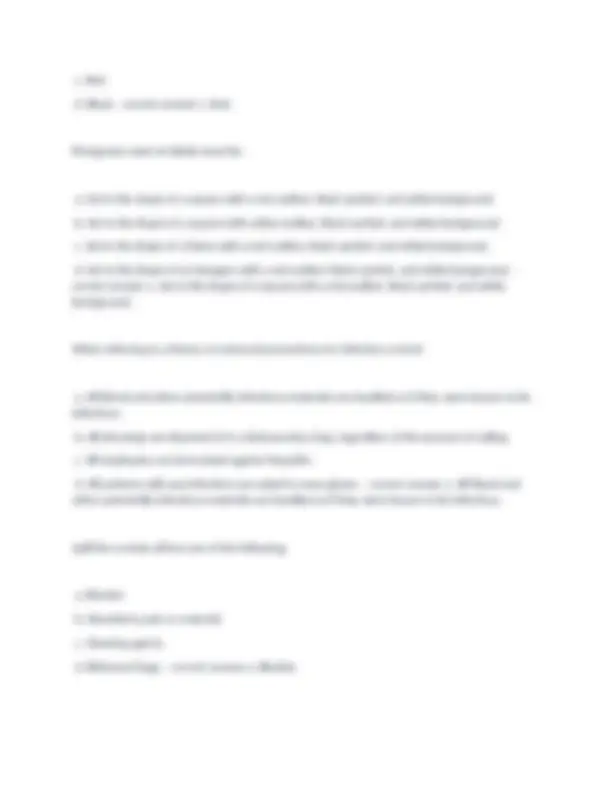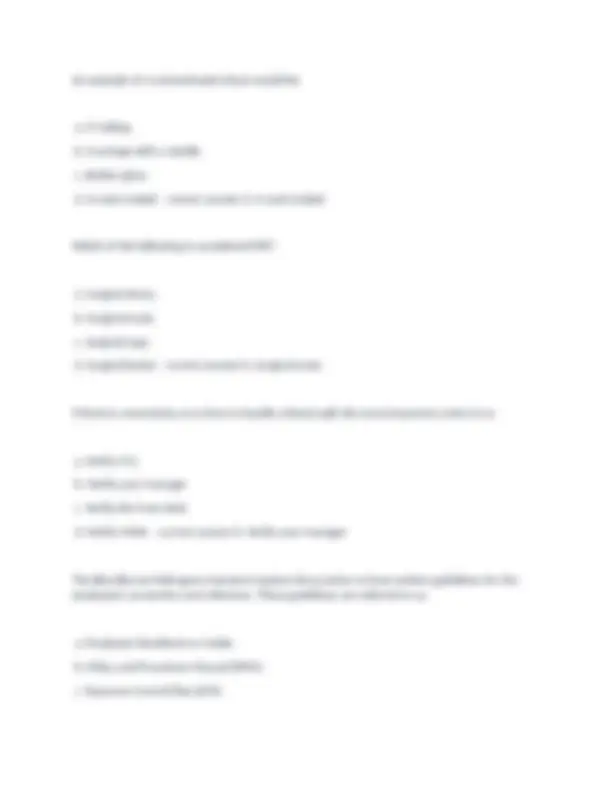





Study with the several resources on Docsity

Earn points by helping other students or get them with a premium plan


Prepare for your exams
Study with the several resources on Docsity

Earn points to download
Earn points by helping other students or get them with a premium plan
Community
Ask the community for help and clear up your study doubts
Discover the best universities in your country according to Docsity users
Free resources
Download our free guides on studying techniques, anxiety management strategies, and thesis advice from Docsity tutors
A comprehensive q&a guide on osha regulations, bloodborne pathogens, and hazard communication for the year 2023. It covers topics such as osha standards, training dates, immunization, infection prevention methods, ppe, changes in the hcs, labeling requirements, household products for disinfection, biohazardous waste disposal, precautions to avoid occupational exposure, identification of biohazardous material, labeling of pictograms, theory of universal precautions, spill kit contents, contaminated sharps, ppe examples, handling uncertain blood spills, written guidelines for employee protection, and the enforcement agency for compliance with the bloodborne pathogens standard.
Typology: Exams
1 / 6

This page cannot be seen from the preview
Don't miss anything!




OSHA stands for: a. Occupational and Safe Health Administration. b. Ophthalmic Standards for Healthcare Administration. c. Ophthalmic Safety Has Advantages. d. Occupational Safety and Health Administration. - correct answer d. Occupational Safety and Health Administration. Training on the revised Hazard Communication Standard must begin by and end by which of the following dates? a. Beginning December 1, 2012 and ending July 30, 2015 b. Beginning December 1, 2013 and ending June 1, 2016 c. Beginning December 1, 2012 and ending June 1, 2016 d. Beginning December 1, 2013 and ending July 30, 2015 - correct answer b. Beginning December 1, 2013 and ending June 1, 2016 Immunization is provided for employees with occupational exposure for what disease? a. Hepatitis A. b. Hepatitis B. c. Hepatitis C. d. Hepatitis D. - correct answer b. Hepatitis B.
What is the single most important method to prevent the spread of infection? a. Washing your hands. b. Covering your cough. c. Using a biohazard container for contaminated products. d. Using disinfectants to clean surfaces. - correct answer a. Washing your hands. What is PPE? a. Policies, Procedures, Equipment. b. Personal Protective Equipment. c. Personal Provider Elements. d. Protection Produced Elements. - correct answer b. Personal Protective Equipment. The two new changes in the HCS are: a. SDS and label elements. b. MSDS updates and label elements. c. Hazardous chemicals and label elements. d. MSDS and hazardous chemicals. - correct answer a. SDS and label elements. Labels must now include new information including: a. Product identifier. b. Histogram. c. MSDS sheets. d. Email address. - correct answer a. Product identifier.
c. Red. d. Black. - correct answer c. Red. Pictograms used on labels must be: a. Set in the shape of a square with a red outline, black symbol, and white background. b. Set in the shape of a square with a blue outline, black symbol, and white background. c. Set in the shape of a flame with a red outline, black symbol, and white background. d. Set in the shape of an hexagon with a red outline, black symbol, and white background. - correct answer a. Set in the shape of a square with a red outline, black symbol, and white background. When referring to a theory of universal precautions for infection control: a. All blood and other potentially infectious materials are handled as if they were known to be infectious. b. All dressings are disposed of in a biohazardous bag, regardless of the amount of soiling. c. All employees are immunized against hepatitis. d. All patients with eye infections are asked to wear gloves. - correct answer a. All blood and other potentially infectious materials are handled as if they were known to be infectious. Spill kits contain all but one of the following: a. Blanket. b. Absorbent pads or material. c. Cleaning agents. d. Biohazard bags. - correct answer a. Blanket.
An example of a contaminated sharp would be: a. IV tubing. b. A syringe with a needle. c. Broken glass. d. A used scalpel. - correct answer d. A used scalpel. Which of the following is considered PPE? a. Surgical shoes. b. Surgical mask. c. Surgical tape. d. Surgical locker. - correct answer b. Surgical mask. If there is uncertainty as to how to handle a blood spill, the most important action is to: a. Notify 911. b. Notify your manager c. Notify the front desk. d. Notify OSHA. - correct answer b. Notify your manager The Bloodborne Pathogens Standard requires the practice to have written guidelines for the employees' protection and reference. These guidelines are referred to as: a. Employee Handbook or Guide. b. Policy and Procedure Manual (PPM). c. Exposure Control Plan (ECP).